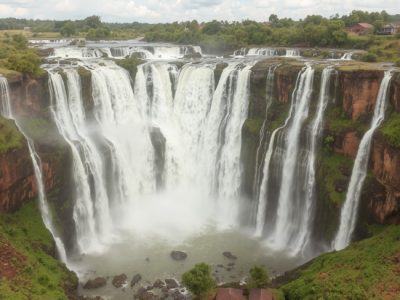Motherland’s Natural Landmarks: Mosi-oa-Tunya (Victoria Falls)

Mosi oa Tunya, the Smoke that Thunders (Image: Gencraft)
Mosi-oa-Tunya: Africa’s Majestic Victoria Falls
In the heart of Southern Africa, the mighty Zambezi River plunges into a deep gorge, creating a thundering curtain of mist and water. This is Mosi-oa-Tunya, “The Smoke That Thunders,” known globally as Victoria Falls. Straddling the border between Zambia and Zimbabwe, this natural wonder is not just a sight to behold—it’s a roaring symbol of Africa’s grandeur.
Africa’s Largest Waterfall
Victoria Falls is the largest waterfall in the world—not by height or width alone, but by the sheer volume of water that crashes down every minute. It stretches 1,708 meters (5,604 feet) wide and towers 108 meters (354 feet) high. On average, 550,000 cubic meters of water thunder over the edge every minute during peak season, forming the largest sheet of falling water on Earth.
The waterfall gets its life from the Zambezi River, Africa’s fourth-longest river and the largest one flowing into the Indian Ocean. This mighty river fuels the falls through two strikingly different seasons:
-
Wet season (November to April): Water levels rise dramatically, and the falls roar with full force. By April, the spray shoots up to 400 meters into the sky—sometimes even double that.
-
Dry season (May to October): Water levels drop, revealing rock formations and pools, including the daring Devil’s Pool, where adventurous visitors can swim at the edge.
A Name Echoing Through Time
Long before European explorers arrived, local communities gave the falls their original name: Mosi-oa-Tunya, meaning “The Smoke That Thunders.” It captured both the roaring sound and towering spray that can be seen and heard from miles away.
In 1855, Scottish explorer David Livingstone became the first European to see the falls. Overwhelmed by its beauty, he renamed it Victoria Falls in honour of Queen Victoria. Today, both names are used across the world, acknowledging the site’s colonial history while honouring its indigenous roots.
Two Countries, Two Unique Views
The falls are shared between Zambia and Zimbabwe, each offering a unique experience:
-
Zambia controls about two-thirds of the actual waterfall. It’s home to Mosi-oa-Tunya National Park and Livingstone Island, where Livingstone first set eyes on the falls. Adventurous visitors can swim in the Devil’s Pool or walk across Knife-Edge Bridge for a dramatic view.
-
Zimbabwe holds most of the panoramic viewing points. Victoria Falls National Park gives access to about 80% of the falls’ views, perfect for photographers and first-time visitors. From this side, you can truly feel the scale, power, and majesty of the falls.
A Natural Wonder of the World
Victoria Falls is listed among the Seven Natural Wonders of the World and is a UNESCO World Heritage Site. This status helps preserve the falls and their surrounding ecosystem from unchecked development or environmental harm.
Despite its global fame, Victoria Falls retains a raw, untamed energy. The local wildlife includes elephants, baboons, hippos, and hundreds of bird species. The air is alive with the sound of crashing water and the call of the wild.
Eco-conscious development has made the site accessible without destroying its natural charm. Visitors can enjoy guided tours, cultural performances, river cruises, and thrilling activities like bungee jumping and white-water rafting.
More Than a Tourist Attraction
Victoria Falls is not just a place for photos and souvenirs. It is sacred land to the Tonga and Lozi people who have lived near the falls for centuries. To them, the mist and thunder are the breath and voice of ancestral spirits. The falls remain a symbol of cultural pride and natural power.
Each year, thousands of Africans and international tourists visit the site to reconnect with nature, explore African history, and witness one of Earth’s most powerful spectacles.
Why Mosi-oa-Tunya Matters
-
Cultural Significance: A spiritual site for local communities.
-
Natural Power: Home to Earth’s largest curtain of falling water.
-
Dual Heritage: Combines indigenous and colonial histories.
-
Global Recognition: A World Heritage Site and a top eco-tourism destination.
At Feelnubia, we celebrate the stories and landmarks that define Africa’s beauty, spirit, and resilience. Mosi-oa-Tunya reminds us that Africa is not just part of world history—it shapes it.
Let the thunder speak. Let the smoke rise. Mosi-oa-Tunya still roars.
